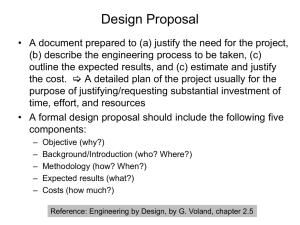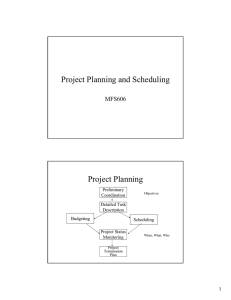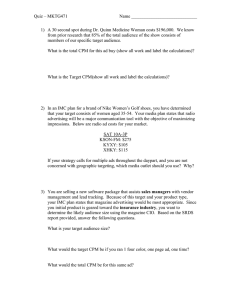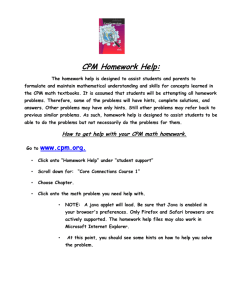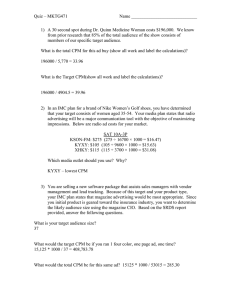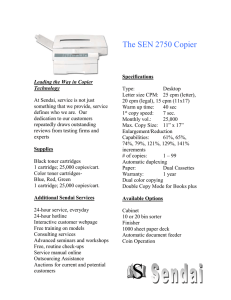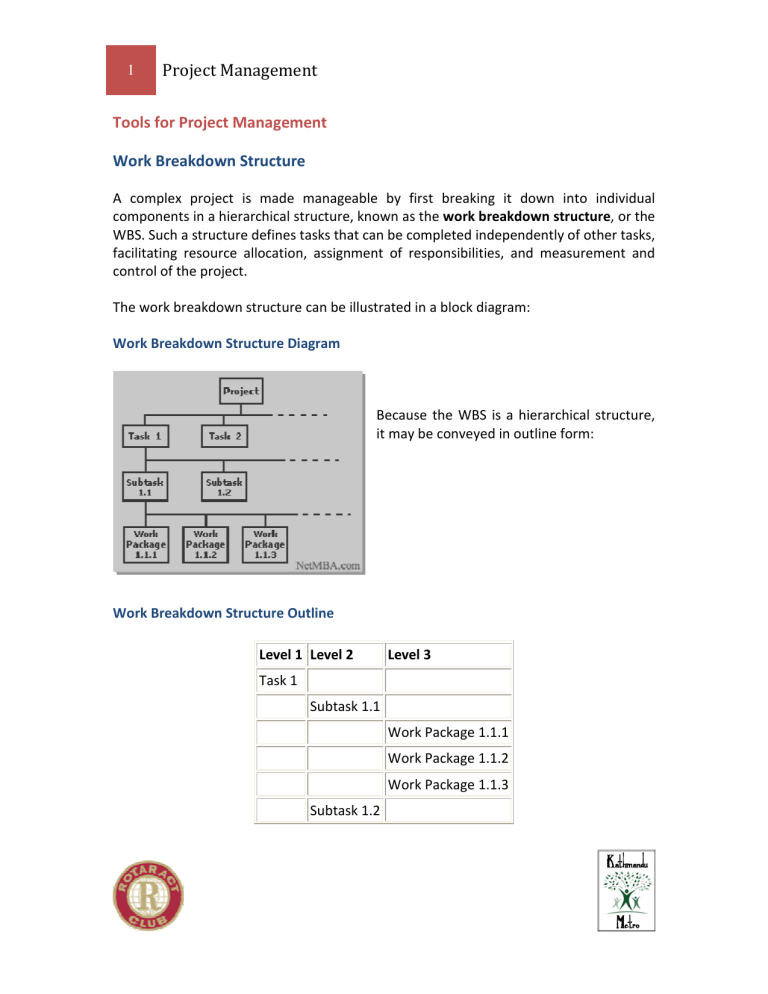
1 Project Management Tools for Project Management Work Breakdown Structure A complex project is made manageable by first breaking it down into individual components in a hierarchical structure, known as the work breakdown structure, or the WBS. Such a structure defines tasks that can be completed independently of other tasks, facilitating resource allocation, assignment of responsibilities, and measurement and control of the project. The work breakdown structure can be illustrated in a block diagram: Work Breakdown Structure Diagram Because the WBS is a hierarchical structure, it may be conveyed in outline form: Work Breakdown Structure Outline Level 1 Level 2 Level 3 Task 1 Subtask 1.1 Work Package 1.1.1 Work Package 1.1.2 Work Package 1.1.3 Subtask 1.2 2 Project Management Work Package 1.2.1 Work Package 1.2.2 Work Package 1.2.3 Task 2 Subtask 2.1 Work Package 2.1.1 Work Package 2.1.2 Work Package 2.1.3 Terminology for Different Levels Each organization uses its own terminology for classifying WBS components according to their level in the hierarchy. For example, some organizations refer to different levels as tasks, sub-tasks, and work packages, as shown in the above outline. Others use the terms phases, entries, and activities. Organization by Deliverables or Phases The WBS may be organized around deliverables or phases of the project life cycle. Higher levels in the structure generally are performed by groups. The lowest level in the hierarchy often comprises activities performed by individuals, though a WBS that emphasizes deliverables does not necessarily specify activities. Level of Detail The breaking down of a project into its component parts facilitates resource allocation and the assignment of individual responsibilities. Care should be taken to use a proper level of detail when creating the WBS. On the one extreme, a very high level of detail is likely to result in micro-management. On the other extreme, the tasks may become too large to manage effectively. Defining tasks so that their duration is between several days and a few months works well for most projects. 3 Project Management WBS's Role in Project Planning The work breakdown structure is the foundation of project planning. It is developed before dependencies are identified and activity durations are estimated. The WBS can be used to identify the tasks in the CPM and PERT project planning models. Gantt chart Gantt Chart During the era of scientific management, Henry Gantt developed a tool for displaying the progression of a project in the form of a specialized chart. An early application was the tracking of the progress of ship building projects. Today, Gantt's scheduling tool takes the form of a horizontal bar graph and is known as a Gantt chart, a basic sample of which is shown below: Gantt Chart Format Task Duration Jan Feb Mar Apr May Jun Jul Aug Sep Oct Nov Dec 1 2 mo. 2 2 mo. 3 2 mo. 4 2 mo. 5 2 mo. 6 2 mo. The horizontal axis of the Gantt chart is a time scale, expressed either in absolute time or in relative time referenced to the beginning of the project. The time resolution depends on the project - the time unit typically is in weeks or months. Rows of bars in the chart show the beginning and ending dates of the individual tasks in the project. In the above example, each task is shown to begin when the task above it completes. However, the bars may overlap in cases where a task can begin before the completion Project Management 4 of another, and there may be several tasks performed in parallel. For such cases, the Gantt chart is quite useful for communicating the timing of the various tasks. For larger projects, the tasks can be broken into subtasks having their own Gantt charts to maintain readability. Gantt Chart Enhancements This basic version of the Gantt chart often is enhanced to communicate more information. • • • • • A vertical marker can used to mark the present point in time. The progression of each activity may be shown by shading the bar as progress is made, allowing the status of each activity to be known with just a glance. Dependencies can be depicted using link lines or color codes. Resource allocation can be specified for each task. Milestones can be shown. Gantt Chart Role in Project Planning For larger projects, a work breakdown structure would be developed to identify the tasks before constructing a Gantt chart. For smaller projects, the Gantt chart itself may used to identify the tasks. The strength of the Gantt chart is its ability to display the status of each activity at a glance. While often generated using project management software, it is easy to construct using a spreadsheet, and often appears in simple ascii formatting in e-mails among managers. CPM CPM - Critical Path Method In 1957, DuPont developed a project management method designed to address the challenge of shutting down chemical plants for maintenance and then restarting the plants once the maintenance had been completed. Given the complexity of the process, they developed the Critical Path Method (CPM) for managing such projects. CPM provides the following benefits: Project Management 5 • • • Provides a graphical view of the project. Predicts the time required to complete the project. Shows which activities are critical to maintaining the schedule and which are not. CPM models the activities and events of a project as a network. Activities are depicted as nodes on the network and events that signify the beginning or ending of activities are depicted as arcs or lines between the nodes. The following is an example of a CPM network diagram: CPM Diagram Steps in CPM Project Planning 1. 2. 3. 4. 5. 6. Specify the individual activities. Determine the sequence of those activities. Draw a network diagram. Estimate the completion time for each activity. Identify the critical path (longest path through the network) Update the CPM diagram as the project progresses. 1. Specify the Individual Activities From the work breakdown structure, a listing can be made of all the activities in the project. This listing can be used as the basis for adding sequence and duration information in later steps. 2. Determine the Sequence of the Activities Some activities are dependent on the completion of others. A listing of the immediate predecessors of each activity is useful for constructing the CPM network diagram. Project Management 6 3. Draw the Network Diagram Once the activities and their sequencing have been defined, the CPM diagram can be drawn. CPM originally was developed as an activity on node (AON) network, but some project planners prefer to specify the activities on the arcs. 4. Estimate Activity Completion Time The time required to complete each activity can be estimated using past experience or the estimates of knowledgeable persons. CPM is a deterministic model that does not take into account variation in the completion time, so only one number is used for an activity's time estimate. 5. Identify the Critical Path The critical path is the longest-duration path through the network. The significance of the critical path is that the activities that lie on it cannot be delayed without delaying the project. Because of its impact on the entire project, critical path analysis is an important aspect of project planning. The critical path can be identified by determining the following four parameters for each activity: • • • • ES - earliest start time: the earliest time at which the activity can start given that its precedent activities must be completed first. EF - earliest finish time, equal to the earliest start time for the activity plus the time required to complete the activity. LF - latest finish time: the latest time at which the activity can be completed without delaying the project. LS - Latest start time, equal to the latest finish time minus the time required to complete the activity. The slack time for an activity is the time between its earliest and latest start time, or between its earliest and latest finish time. Slack is the amount of time that an activity can be delayed past its earliest start or earliest finish without delaying the project. The critical path is the path through the project network in which none of the activities have slack, that is, the path for which ES=LS and EF=LF for all activities in the path. A delay in the critical path delays the project. Similarly, to accelerate the project it is necessary to reduce the total time required for the activities in the critical path. Project Management 7 6. Update CPM Diagram As the project progresses, the actual task completion times will be known and the network diagram can be updated to include this information. A new critical path may emerge, and structural changes may be made in the network if project requirements change. CPM Limitations CPM was developed for complex but fairly routine projects with minimal uncertainty in the project completion times. For less routine projects there is more uncertainty in the completion times, and this uncertainty limits the usefulness of the deterministic CPM model. An alternative to CPM is the PERT project planning model, which allows a range of durations to be specified for each activity. Time-Cost Time-Cost Trade-offs There is a relationship between a project's time to completion and its cost. For some types of costs, the relationship is in direct proportion; for other types, there is a direct trade-off. Because of these two types of costs, there is an optimal project pace for minimal cost. By understanding the time-cost relationship, one is better able to predict the impact of a schedule change on project cost. Types of Costs The costs associated with a project can be classified as direct costs or indirect costs. • • Direct costs are those directly associated with project activities, such as salaries, travel, and direct project materials and equipment. If the pace of activities is increased in order to decrease project completion time, the direct costs generally increase since more resources must be allocated to accelerate the pace. Indirect costs are those overhead costs that are not directly associated with specific project activities such as office space, administrative staff, and taxes. Such costs tend to be relatively steady per unit of time over the life of the project. As such, the total indirect costs decrease as the project duration decreases. 8 Project Management The project cost is the sum of the direct and indirect costs. Compressing the Project Schedule Compressing or crashing the project schedule refers to the acceleration of the project activities in order to complete the project sooner. The time required to complete a project is determined by the critical path, so to compress a project schedule one must focus on critical path activities. A procedure for determining the optimal project time is to determine the normal completion time for each critical path activity and a crash time. The crash time is the shortest time in which an activity can be completed. The direct costs then are calculated for the normal and crash times of each activity. The slope of each cost versus time trade-off can be determined for each activity as follows: Slope = (Crash cost - Normal cost) / (Normal time - Crash time) The activities having the lowest cost per unit of time reduction should be shortened first. In this way, one can step through the critical path activities and create a graph of the total project cost versus the project time. The indirect, direct, and total project costs then can be calculated for different project durations. The optimal point is the duration resulting in the minimum project cost, as show in the following graph: Project Cost Versus Duration Attention should be given to the critical path to make sure that it remains the critical path after the activity time is reduced. If a new critical path emerges, it must consider in subsequent time reductions. Project Management 9 To minimize the cost, those activities that are not on the critical path can be extended to minimize their costs without increasing the project completion time. Time-Cost Model Assumptions The time-cost model described above relies on the following assumptions: • • • The normal cost for an activity is lower than the crash cost. There is a linear relationship between activity time and cost. The resources are available to shorten the activity. The model would need to be adapted to cases in which the assumptions do not hold. For example, the schedule might need to take into account the need to level the load on a limited resource such as a specialized piece of equipment. Additional Considerations There are other considerations besides project cost. For example, when the project is part of the development of a new product, time-to-market may be extremely important and it may be beneficial to accelerate the project to a point where its cost is much greater than the minimum cost. In contract work, there may be incentive payments associated with early completion or penalties associated with late completion. A time-cost model can be adapted to take such incentives and penalties into account by modeling them as indirect costs. Because of the importance of the critical path in compressing a project schedule, a project planning technique such as the Critical Path Method or PERT should be used to identify the critical path before attempting to compress the schedule.
